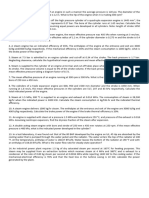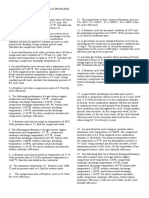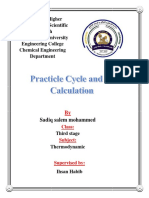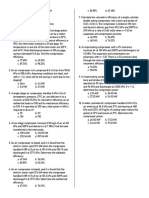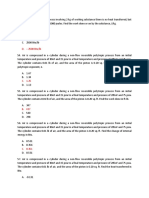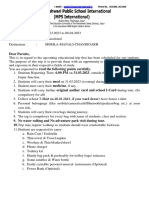0 ratings0% found this document useful (0 votes)
541 viewsProblem Set - Midterm
This document contains 26 psychrometric problems involving air-conditioning systems. The problems cover a range of calculations including determining exit conditions given inlet conditions and cooling/heating rates, determining heat and mass transfer rates, and mixing of air streams. The document provides the problem statements and numerical answers for engineering calculations involving properties of air such as temperature, humidity, enthalpy, and flow rates.
Uploaded by
John Paul JacalanCopyright
© © All Rights Reserved
Available Formats
Download as DOCX, PDF, TXT or read online on Scribd
0 ratings0% found this document useful (0 votes)
541 viewsProblem Set - Midterm
This document contains 26 psychrometric problems involving air-conditioning systems. The problems cover a range of calculations including determining exit conditions given inlet conditions and cooling/heating rates, determining heat and mass transfer rates, and mixing of air streams. The document provides the problem statements and numerical answers for engineering calculations involving properties of air such as temperature, humidity, enthalpy, and flow rates.
Uploaded by
John Paul JacalanCopyright
© © All Rights Reserved
Available Formats
Download as DOCX, PDF, TXT or read online on Scribd
You are on page 1/ 3
Assignment – Psychrometry psia, 50°F, and 40 percent relative humidity at a
velocity of 25 ft/s. Determine (a) the exit
1. An 8 m3-tank contains saturated air at 30°C, 105 temperature, (b) the exit relative humidity of
kPa. Determine (a) the mass of dry air, (b) the the air, and (c) the exit velocity. Ans: T2 =
specific humidity, and (c) the enthalpy of the air
56.6°F; RH = 31.4 %; v2 = 25.4 ft/s
per unit mass of the dry air. Ans: ma = 9.264 kg; 11. Air enters a 40-cm-diameter cooling section at 1
ω = 0.0262 kgv/kga; h = 97.1 kJ/kga atm, 32°C, and 30 percent relative humidity at
2. A tank contains 21 kg of dry air and 0.3 kg of 18 m/s. Heat is removed from the air at a rate
water vapor at 30°C and 100 kPa total pressure. of 1200 kJ/min. Determine (a) the exit
Determine (a) the specific humidity, (b) the temperature, (b) the exit relative humidity of
relative humidity, and (c) the volume of the the air, and (c) the exit velocity. Ans: T2 =
tank. Ans: ω = 0.0143 kgv/kga; RH = 52.9 %; V = 24.4°C; RH = 46.6 %; v2 = 17.6 m/s
18.7 m3 12. Air at 1 atm, 15°C, and 60 percent relative
3. A room contains air at 20°C and 98 kPa at a humidity is first heated to 20°C in a heating
relative humidity of 85 percent. Determine (a) section and then humidified by introducing
the partial pressure of dry air, (b) the specific water vapor. The air leaves the humidifying
humidity of the air, and (c) the enthalpy per unit section at 25°C and 65 percent relative
mass of dry air. Ans: Pa = 96.01 kPa; ω = 0.0129 humidity. Determine (a) the amount of steam
kgv/kga; h = 52.78 kJ/kga added to the air, and (b) the amount of heat
4. A room contains air at 70°F and 14.6 psia at a
transfer to the air in the heating section. Ans: ω
relative humidity of 85 percent. Determine (a)
= 0.0065 kgv/kga; q = 5.1 kJ/kga
the partial pressure of dry air, (b) the specific
13. Air at 14.7 psia, 50°F, and 60 percent relative
humidity, and (c) the enthalpy per unit mass of
humidity is first heated to 72°F in a heating
dry air. Ans: Pa = 14.291 psi; ω = 0.0134 lbv/lba;
section and then humidified by introducing
h = 31.43 Btu/lba
water vapor. The air leaves the humidifying
5. Determine the masses of dry air and the water
section at 75°F and 55 percent relative
vapor contained in a 240-m3 room at 98 kPa,
humidity. Determine (a) the amount of steam
23°C, and 50 percent relative humidity. Ans: ma
added to the air, in lbm H2O/lbm dry air, and (b)
= 272.9 kg; mv = 2.47 kg
the amount of heat transfer to the air in the
6. The dry- and wet-bulb temperatures of
heating section, in Btu/lbm dry air. Ans: Δω =
atmospheric air at 95 kPa are 25 and 17°C,
0.0056 lbv/lba; q = 5.3 Btu/lba
respectively. Determine (a) the specific
14. An air-conditioning system operates at a total
humidity, (b) the relative humidity, and (c) the
pressure of 1 atm and consists of a heating
enthalpy of the air, in kJ/kg dry air. Ans: ω1 =
section and a humidifier that supplies wet
0.00963 kgv/kga; RH1 = 45.7 %; h1 = 49.65 kJ/kga
steam (saturated water vapor) at 100°C. Air
7. The air in a room has a dry-bulb temperature of
enters the heating section at 10°C and 70
22°C and a wet-bulb temperature of 16°C.
percent relative humidity at a rate of 35
Assuming a pressure of 100 kPa, determine (a)
m3/min, and it leaves the humidifying section at
the specific humidity, (b) the relative humidity,
20°C and 60 percent relative humidity.
and (c) the dew-point temperature. Ans: ω =
Determine (a) the temperature and relative
0.0090 kgv/kga; RH = 54.1 %; Tdp = 12.3°C humidity of air when it leaves the heating
8. The air in a room has a dry-bulb temperature of section, (b) the rate of heat transfer in the
80°F and a wet-bulb temperature of 65°F. heating section, and (c) the rate at which water
Assuming a pressure of 14.7 psia, determine (a) is added to the air in the humidifying section.
the specific humidity, (b) the relative humidity, Ans: T2 = 19.5oC; RH2 = 37.8 %; Q = 420 kJ/min;
and (c) the dew-point temperature. Ans: ω = mw = 0.15 kg/min
0.0097 lbv/lba; RH = 44.7 %; Tdp = 56.6°F 15. Air enters a window air conditioner at 1 atm,
9. Air enters a heating section at 95 kPa, 12°C, and 32°C, and 70 percent relative humidity at a rate
30 percent relative humidity at a rate of 6 of 2 m3/min, and it leaves as saturated air at
m3/min, and it leaves at 25°C. Determine (a) the 15°C. Part of the moisture in the air that
rate of heat transfer in the heating section and condenses during the process is also removed
(b) the relative humidity of the air at the exit. at 15°C. Determine the rates of heat and
Ans: Q = 91.1 kJ/min; RH = 13.3 % moisture removal from the air. Ans: 97.7
10. A heating section consists of a 15-in.-diameter kJ/min; 0.023 kg/min
duct that houses a 4-kW electric resistance
heater. Air enters the heating section at 14.7
16. An air-conditioning system is to take in air at 1 m3/min and leaves at 22°C. Determine (a) the
atm, 34°C, and 70 percent relative humidity and final relative humidity and (b) the amount of
deliver it at 22°C and 50 percent relative water added to air. Ans: RH2 = 80 %
humidity. The air flows first over the cooling 23. What is the lowest temperature that air can
coils, where it is cooled and dehumidified, and attain in an evaporative cooler if it enters at 1
then over the resistance heating wires, where it atm, 29°C, and 40 percent relative humidity?
is heated to the desired temperature. Assuming Ans: Tmin = 19.3°C
that the condensate is removed from the 24. Two airstreams are mixed steadily and
cooling section at 10°C, determine (a) the adiabatically. The first stream enters at 32°C
temperature of air before it enters the heating and 40 percent relative humidity at a rate of 20
section, (b) the amount of heat removed in the m3/min, while the second stream enters at 12°C
cooling section, and (c) the amount of heat and 90 percent relative humidity at a rate of 25
transferred in the heating section, both in kJ/kg m3/min. Assuming that the mixing process
dry air. Ans: T2 = 11.1oC; qout = 62.7 kJ/kga; qin = occurs at a pressure of 1 atm, determine the
11.3 kJ/kga specific humidity, the relative humidity, the dry-
17. Air enters a 30-cm-diameter cooling section at 1 bulb temperature, and the volume flow rate of
atm, 35°C, and 60 percent relative humidity at the mixture. Ans: ω3 = 0.0096 kgv/kga; RH3 =
120 m/min. The air is cooled by passing it over a 63.4 %; T3 = 20.6°C; V3 = 45.0 m3/min
cooling coil through which cold water flows. The 25. During an air-conditioning process, 900 ft3/min
water experiences a temperature rise of 8°C. of conditioned air at 65°F and 30 percent
The air leaves the cooling section saturated at relative humidity is mixed adiabatically with 300
20°C. Determine (a) the rate of heat transfer, ft3/min of outside air at 80°F and 90 percent
(b) the mass flow rate of the water, and (c) the relative humidity at a pressure of 1 atm.
exit velocity of the airstream. Ans: Q = 302.3 Determine (a) the temperature, (b) the specific
kJ/min; mw = 9.04 kg/min; v2 = 113 m/min humidity, and (c) the relative humidity of the
18. Air enters a 1-ft-diameter cooling section at mixture. Ans: T3 = 68.7°F; ω3 = 0.0078 lbv/lba;
14.7 psia, 90°F, and 60 percent relative RH = 52.1 %
humidity at 600 ft/min. The air is cooled by 26. A stream of warm air with a dry-bulb
passing it over a cooling coil through which cold temperature of 40°C and a wet-bulb
water flows. The water experiences a temperature of 32°C is mixed adiabatically with
temperature rise of 14°F. The air leaves the a stream of saturated cool air at 18°C. The dry
cooling section saturated at 70°F. Determine (a) air mass flow rates of the warm and cool
the rate of heat transfer, (b) the mass flow rate airstreams are 8 and 6 kg/s, respectively.
of the water, and (c) the exit velocity of the Assuming a total pressure of 1 atm, determine
airstream. Ans: Q = 255.6 Btu/min; mw = 18.3 (a) the temperature, (b) the specific humidity,
lb/min; v2 = 577 ft/min and (c) the relative humidity of the mixture.
19. Air enters an evaporative cooler at 1 atm, 36°C, Ans: ω3 = 0.0211 kgv/kga; T3 = 30.7oC; RH3 =
and 20 percent relative humidity at a rate of 4 75.1 %
m3/min, and it leaves with a relative humidity of 27. A dehumidifier is used to extract excess
90 percent. Determine (a) the exit temperature moisture from the air inside a room with
of the air and (b) the required rate of water pressure of 107 kPa and dimensions of 8x6x3
supply to the evaporative cooler. Ans: T2 = m3. The room was initially at a dry bulb
20.5oC temperature of 30oC, 70% relative humidity and
20. Air enters an evaporative cooler at 14.7 psia, ends up at a wet bulb temperature of 11oC,
90°F, and 20 percent relative humidity at a rate 100% relative humidity. What mass of water
of 150 ft3/min, and it leaves with a relative vapor has been removed by the dehumidifier (in
humidity of 90 percent. Determine (a) the exit kg)?
temperature of air and (b) the required rate of Ans: 1.77 kgv
water supply to the evaporative cooler. Ans: T2 28. In a moist environment the moisture content is
= 65°F; mw = 0.06 lb/min 20 grams of vapor per kilogram of dry air and
21. Air enters an evaporative cooler at 101.325 kPa, the dry bulb temperature is 20oC. What is the
40°C, and 25 percent relative humidity and exits dew point of the moist air (in oC)? (Assume that
saturated. Determine the exit temperature of the environment is at atmospheric pressure)
air. Ans: T2 = 23.5°C Ans: 24.93oC
22. Air enters an evaporative cooler at 1 atm, 32°C, 29. A room has a saturation vapor pressure of 3.2
and 30 percent relative humidity at a rate of 5 kPa and a dry bulb temperature of 25oC. If the
relative humidity is 70%, what is the vapor
pressure of the humid air (in kPa)?
Ans: 2.24 kPa
30. On a hot humid day, when the pressure is 103
kPa, the temperature is 28oC and the relative
humidity is 100%, Bill takes an empty 1 liter
bottle that has been left open to the air, seals
the bottle by putting on its lid, and puts the
bottle into his fridge which is at a temperature
of 5oC. Assume the density of water to be 1000
kg/m3. What volume of condensation will form
in the bottle in (in μl)?
Ans: 21.13 μl
You might also like
- Mechanical Engineering Problems Set 1 MathNo ratings yetMechanical Engineering Problems Set 1 Math24 pages
- Emittance R Emittance R Config. Factor RNo ratings yetEmittance R Emittance R Config. Factor R6 pages
- Power Plant and Industrial Plant Design Pre-Board/RefresherNo ratings yetPower Plant and Industrial Plant Design Pre-Board/Refresher13 pages
- (x3) Problem 1 - 4 Industrial CompressorNo ratings yet(x3) Problem 1 - 4 Industrial Compressor13 pages
- Putrika Citta Pramesi 14/369486/TP/11122: 1 2 Container P, Container Freeze Latent P, Fresh P, FrozenNo ratings yetPutrika Citta Pramesi 14/369486/TP/11122: 1 2 Container P, Container Freeze Latent P, Fresh P, Frozen2 pages
- صادق سالم محمد Practicle Cycle and its CalculationNo ratings yetصادق سالم محمد Practicle Cycle and its Calculation18 pages
- SET B With Answer Key Quiz 2 Fluid Machineries (Prof. Enh. 2)No ratings yetSET B With Answer Key Quiz 2 Fluid Machineries (Prof. Enh. 2)4 pages
- Heat Transfer: Precious Arlene Villaroza-MelendrezNo ratings yetHeat Transfer: Precious Arlene Villaroza-Melendrez33 pages
- 1.1 Development of Compressed Air EngineeringNo ratings yet1.1 Development of Compressed Air Engineering4 pages
- Section 1: Photograpgh Questions TranscriptNo ratings yetSection 1: Photograpgh Questions Transcript44 pages
- [Ebooks PDF] download Urban Climate Change and Heat Islands Riccardo Paolini full chapters100% (1)[Ebooks PDF] download Urban Climate Change and Heat Islands Riccardo Paolini full chapters57 pages
- The Determination of Nitrogen According To Kjeldahl Using Block Digestion and Steam Distillation100% (1)The Determination of Nitrogen According To Kjeldahl Using Block Digestion and Steam Distillation14 pages
- 10. Đề thi thử THPT Quốc gia 2020 môn Anh THPT Chuyên Thái Bình - Lần 2 (có lời giải chi tiết)0% (1)10. Đề thi thử THPT Quốc gia 2020 môn Anh THPT Chuyên Thái Bình - Lần 2 (có lời giải chi tiết)22 pages
- Necessity and Applications of RefrigerationNo ratings yetNecessity and Applications of Refrigeration15 pages
- Visual Guide to Phrasal Verbs - Part 1 - 4 - BreakNo ratings yetVisual Guide to Phrasal Verbs - Part 1 - 4 - Break9 pages
- Review: Illusion by Paula Volsky: AboutNo ratings yetReview: Illusion by Paula Volsky: About14 pages
- HVAC Controls - Operation and MaintenanceNo ratings yetHVAC Controls - Operation and Maintenance330 pages
- L. Poorter, F. Bongers, F.N. Kouamý, W.D. Hawthorne Biodiversity of West African Forests 2004No ratings yetL. Poorter, F. Bongers, F.N. Kouamý, W.D. Hawthorne Biodiversity of West African Forests 2004528 pages
- Grade 7 Social science Notes (2022-2023)No ratings yetGrade 7 Social science Notes (2022-2023)33 pages
















